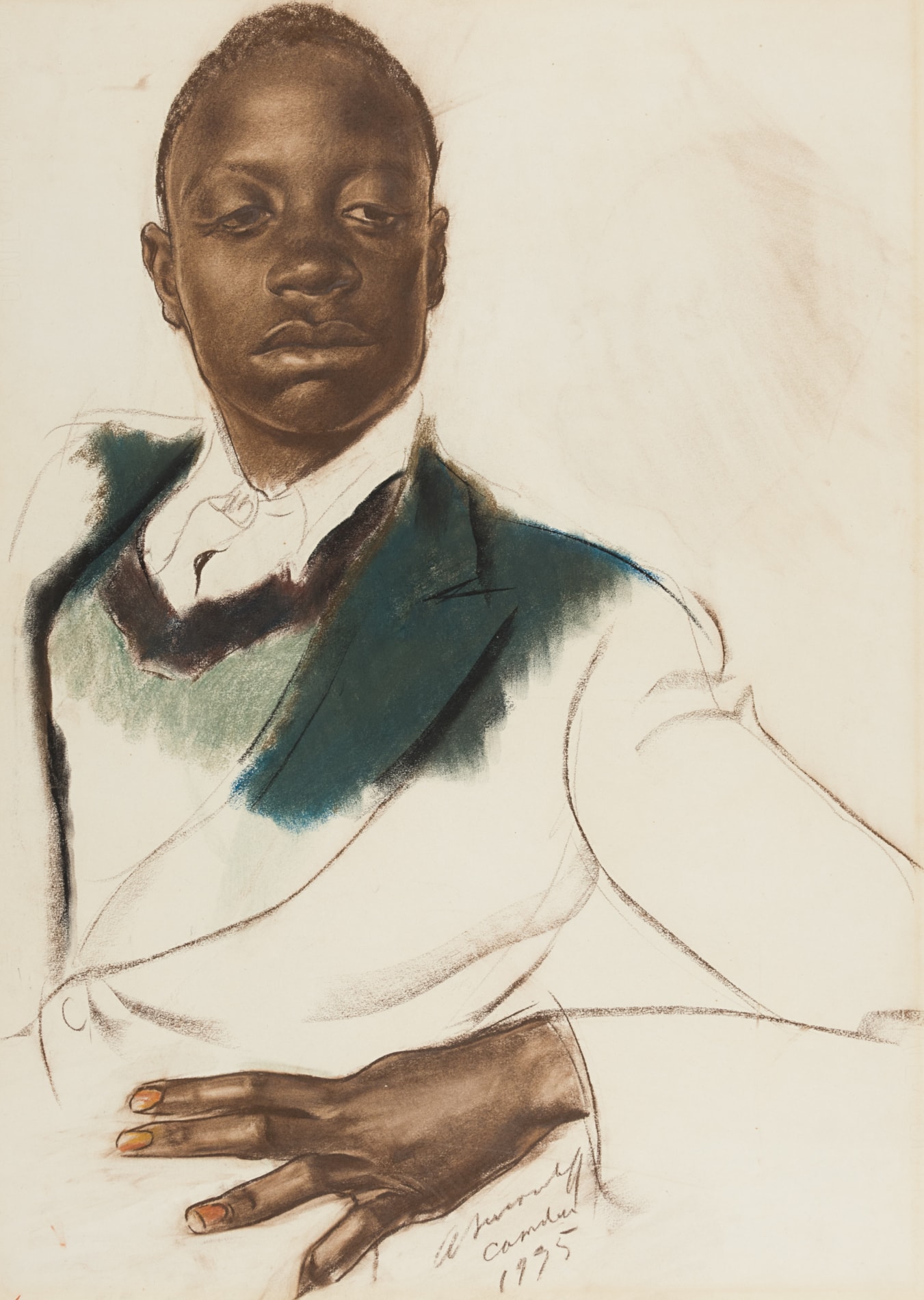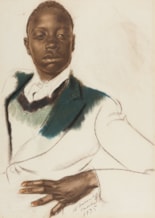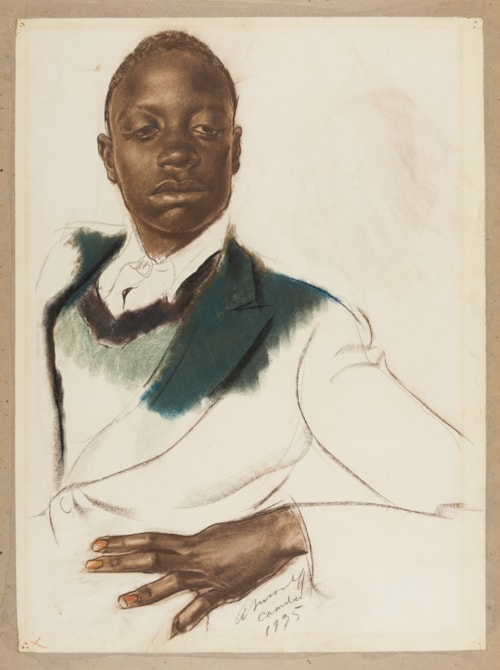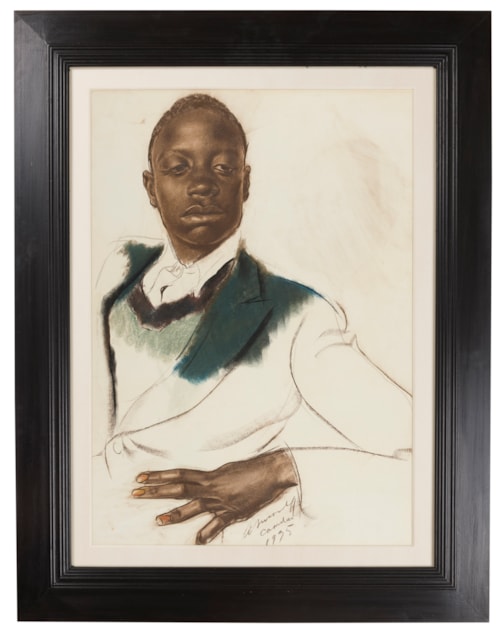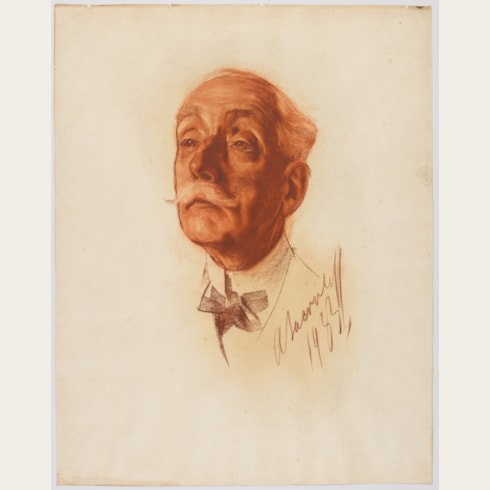Alexander YAKOVLEV
(St. Petersburg 1887 - Paris 1938)
Portrait of a Black Man, South Carolina
Sold
Charcoal, pastel and pencil.
Laid down.
Signed, inscribed and dated A. Iacovleff / Camden / 1935 at the lower centre.
660 x 487 mm. (26 x 19 1/4 in.)
Laid down.
Signed, inscribed and dated A. Iacovleff / Camden / 1935 at the lower centre.
660 x 487 mm. (26 x 19 1/4 in.)
This large and striking portrait drawing was made during a stay by Alexander Yakovlev in the city of Camden in South Carolina in 1935, during which time he seems to have produced a number of portraits, as well as at least two depictions of a dance hall scene. The following year, in 1936, an exhibition of the artist’s work at the Knoedler Gallery in New York included three drawings entitled Josephine (Camden, South Carolina), The Black Plumber (Camden, South Carolina) and Cariebell (Camden, South Carolina). A few months later, another exhibition of Yakovlev’s work was mounted at the Gibbes Art Gallery of the Carolina Art Association in Charleston, South Carolina, and included some of the same works.
In 1938, a number of other drawings of Black subjects in South Carolina – possibly counting the present sheet - were included in an exhibition of Yakovlev’s paintings and drawings at the Carnegie Institute in Pittsburgh. A review of that exhibition praised the ‘remarkable creative ability, an amazing productive power, great technical skill, incredible versatility as to style and the use of artistic medium, superb draftsmanship, and a cosmopolitan understanding, sympathy, and outlook’ of the works displayed, adding that ‘Iacovleff’s ability as a draftsman is best seen in his drawings, where with a few bold strokes of his pencil or crayon, he outlines a head, an arm, a body, or a piece of drapery.’
The present sheet was formerly in the possession of the artist’s younger sister, Alexandra Yakovleva (1889-1979), an opera singer who, with her mother, escaped Russia after the Revolution and settled with her brother in Paris. From 1949 until her death thirty years later, Yakovleva taught at the Conservatoire Russe Serge Rachmaninoff in Paris.
In 1938, a number of other drawings of Black subjects in South Carolina – possibly counting the present sheet - were included in an exhibition of Yakovlev’s paintings and drawings at the Carnegie Institute in Pittsburgh. A review of that exhibition praised the ‘remarkable creative ability, an amazing productive power, great technical skill, incredible versatility as to style and the use of artistic medium, superb draftsmanship, and a cosmopolitan understanding, sympathy, and outlook’ of the works displayed, adding that ‘Iacovleff’s ability as a draftsman is best seen in his drawings, where with a few bold strokes of his pencil or crayon, he outlines a head, an arm, a body, or a piece of drapery.’
The present sheet was formerly in the possession of the artist’s younger sister, Alexandra Yakovleva (1889-1979), an opera singer who, with her mother, escaped Russia after the Revolution and settled with her brother in Paris. From 1949 until her death thirty years later, Yakovleva taught at the Conservatoire Russe Serge Rachmaninoff in Paris.
Alexander Evgenievich Yakovlev (also Iacovleff or Jacovleff) studied at the Imperial Academy of Fine Arts in St. Petersburg, where he was taught by Dmitry Kardovksy. It was there that he met his friend and fellow artist, Vasily Shukaev, with whom he travelled to Italy and Spain in 1913. This was to be the first of many travels for Yakovlev. A member of the revived Mir iskusstva group of Russian artists, he was much admired by one of the movement’s founders and leaders, Alexander Benois, who praised the young man’s talent. Following a period of military service during the First World War, Yakovlev earned a travelling scholarship to the Far East in the summer of 1917, and visited Mongolia, China and Japan. He was in Peking during the outbreak of the October Revolution, and was never to return to Russia. After some years in Peking, where he was particularly captivated by Chinese theatre, Yakovlev travelled across Mongolia and Japan, making drawings and sketches of the people and sights he encountered, some of which were exhibited in Shanghai in 1918. He settled in Paris in 1919, and the following year an exhibition of his drawings and paintings of the Far East, at the Galerie Barbazanges in Paris, made his name and established his reputation as an artiste-voyageur and a superb draughtsman. Yakovlev took French citizenship and worked on commissions for decorative mural and fresco paintings for the homes of such private patrons as the Duchesse de Gramont and Prince Yusupov. He continued to travel, however, and later kept a studio in Capri.
In 1924 Yakovlev was invited by the industrialist André Citröen to join ‘La Croisière Noire’ - a motorized expedition, sponsored by Citröen and led by Georges-Marie Haardt, to cross the African continent from Algeria to Madagascar – as its official artist. Between 1924 and 1925 the artist made hundreds of paintings and drawings of the people, animals and landscapes that the expedition encountered on its route, which were later developed into finished works in his studio in Paris. These were exhibited, to considerable critical acclaim, at the Galerie Jean Charpentier and the Pavillon de Marsan at the Louvre. In 1928 Yakovlev sent an exhibition of his work to Moscow, and three years later he joined a second Citröen expedition; the trans-Asiatic ‘La Croisière Jaune’ from Beirut to Peking. Departing in April 1931, the expedition crossed Lebanon, Iraq, Iran, Afghanistan, the Himalayas and the Gobi Desert before arriving in Peking in February 1932. The artist’s painting and drawings from ‘La Croisière Jaune’ were again shown at the Galerie Jean Charpentier in Paris in 1933. The following year Yakovlev accepted a position as the director of the painting and drawing department of the School of the Museum of Fine Arts in Boston, where he remained until 1937. Although exhibitions of his work were held in Washington, D.C., New York, Charleston and Pittsburgh, the artist missed Europe. Not long after his return to Paris, Yakovlev died of stomach cancer, a few weeks before his fifty-first birthday.
In 1924 Yakovlev was invited by the industrialist André Citröen to join ‘La Croisière Noire’ - a motorized expedition, sponsored by Citröen and led by Georges-Marie Haardt, to cross the African continent from Algeria to Madagascar – as its official artist. Between 1924 and 1925 the artist made hundreds of paintings and drawings of the people, animals and landscapes that the expedition encountered on its route, which were later developed into finished works in his studio in Paris. These were exhibited, to considerable critical acclaim, at the Galerie Jean Charpentier and the Pavillon de Marsan at the Louvre. In 1928 Yakovlev sent an exhibition of his work to Moscow, and three years later he joined a second Citröen expedition; the trans-Asiatic ‘La Croisière Jaune’ from Beirut to Peking. Departing in April 1931, the expedition crossed Lebanon, Iraq, Iran, Afghanistan, the Himalayas and the Gobi Desert before arriving in Peking in February 1932. The artist’s painting and drawings from ‘La Croisière Jaune’ were again shown at the Galerie Jean Charpentier in Paris in 1933. The following year Yakovlev accepted a position as the director of the painting and drawing department of the School of the Museum of Fine Arts in Boston, where he remained until 1937. Although exhibitions of his work were held in Washington, D.C., New York, Charleston and Pittsburgh, the artist missed Europe. Not long after his return to Paris, Yakovlev died of stomach cancer, a few weeks before his fifty-first birthday.
Provenance
By descent to the artist’s sister, Alexandra Yakovleva, Paris
Acquired from her by a private collector in 1978
Private collection, Rhode Island.
Acquired from her by a private collector in 1978
Private collection, Rhode Island.
Exhibition
Possibly Pittsburgh, Carnegie Institute, Paintings, Water Colors and Drawings by Alexandre Iacovleff, 1938, no.25 (‘Negro, South Carolina’); Possibly New York, Grand Central Art Galleries, Memorial Exhibition of the Work of Alexandre Iacovleff, 1939, no.55 (‘Negro, South Carolina’).

